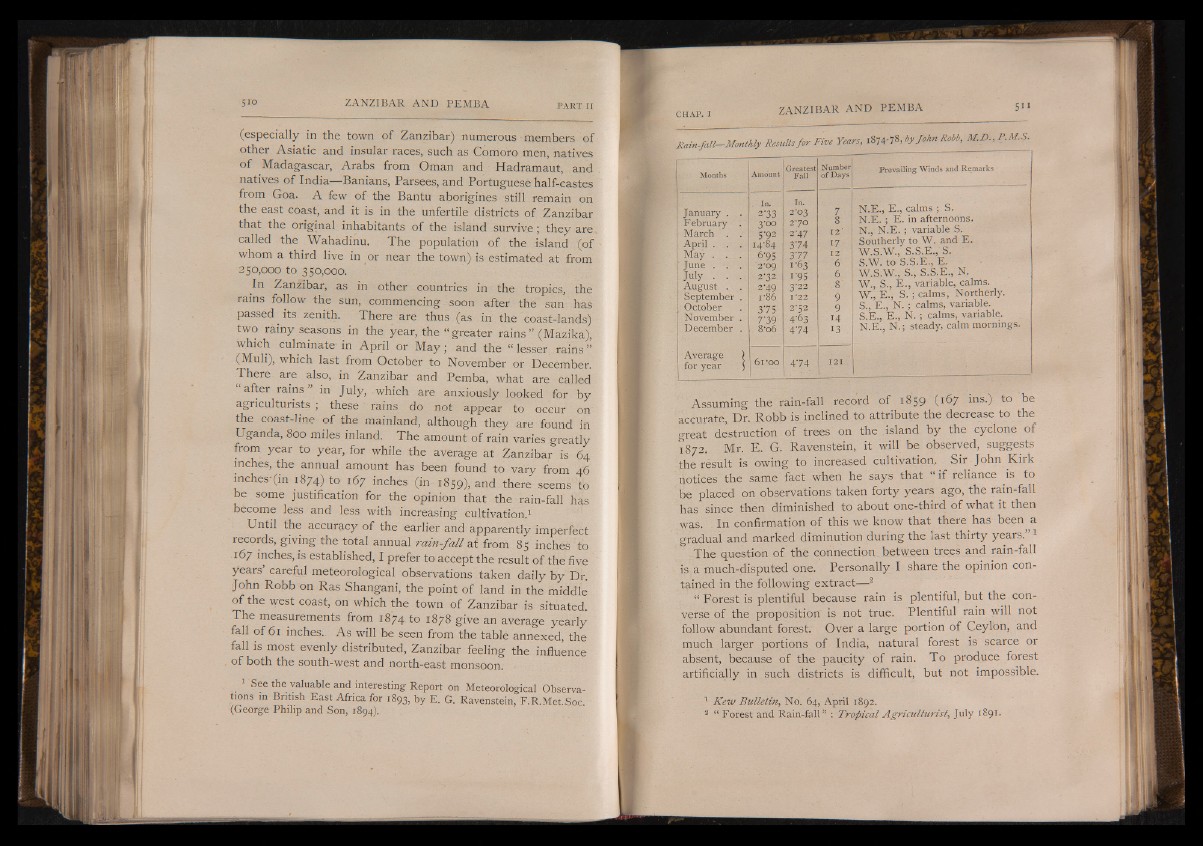
(especially in the town of Zanzibar) numerous members of
other Asiatic and insular races, such as Comoro men, natives
of Madagascar, Arabs from Oman and Hadramaut, and
natives of India— Banians, Parsees, and Portuguese half-castes
from Goa. A few of the Bantu aborigines still remain on
the east coast, and it is in the unfertile districts of Zanzibar
that the original inhabitants of the island survive; they are
called the Wahadinu. The population of the island (of
whom a third live in or near the town) is estimated at from
250,000 to 350,000.
In Zanzibar, as in other countries in the tropics, the
rains follow the sun, commencing soon after the sun has
passed its zenith. There are thus (as in the coast-lands)
two rainy seasons in the year, the “ greater rains”'(Mazika),
which culminate in April or M a y ; and the “ lesser, rains ”
(Muli), which last from October to November or December.
There are also, in Zanzibar and Pemba, what are called
after rains in July, which are anxiously looked for by
agriculturists ; these rains do not appear to occur on
the coast-line of the mainland, although they are found in
Uganda, 800 miles inland. The amount of rain varies greatly
from year to year, for while the average at Zanzibar is 64
inches, the annual amount has been found to vary from 46
inches'(in 1874) to 167 inches (in-1859), and there seems to
be some justification for the opinion that the rain-fall has
become less and less with increasing cultivation.1
Until the accuracy of the earlier and apparently imperfect
records, giving the total annual rain-fall at from 85 inches to
167 inches, is established, I prefer to accept the result of the five
years’ careful meteorological observations taken daily by Dr.
John Robb on Ras Shangani, the point of land in the middle
of the west coast, on which the town of Zanzibar is situated.
The measurements from 1874 to 1878 give an average yearly
fall of 61 inches.. As will be seen from the table annexed, the
fall is most evenly distributed, Zanzibar feeling the influence
of both the south-west and north-east monsoon.
1 See the valuable and interesting Report on Meteorological Observations
in British East Africa for 1893, by E. G. Ravenstein, F.R.Met.Soc.
(George Philip and Son, 1894).
Rain-fall—Monthly Results fo r Five Years, 1874-78, by John Robb, M .D .,P .M .S .
Months Amount
Greatest
Fall
Number
of Days
January , .
In.
3'33
In.
2*03 7
F ebruary . 3’° ° 270 8
March . . 5-92 2'47 12'
April . 14-84 3’74 17
May . .. . 6-95 3‘77 12
June . ; i- 2-09 1-63 6
JDy • 2-32 i '95 6
August . . 2-49 3'22 , 8
September . i-86 I-22 9
October 375 2'52 9
November . 7'39 4'63 14
December . 8-o6 474 13
Average )
for year . ) 6 i-oo 4 7 4 121
Prevailing Winds and Remarks
N.E., E., calms ; S.
N.E. ; E. in afternoons.
N., N .E .; variable S.
Southerly to W. and E.
W.S.W., S.S.E., S.
S.W. to S.S.E., E.
W.S.W., S., S.S.E., N.
W., S., E ., variable, calnis.
W., E., S. ; calms, Northerly.
S., E., N. ; calms, variable.
S.E., E., N. ; calms, variable.
N.E., N.; steady, calm mornings.
Assuming the rain-fall record of 1859 (167 ins.) to be
accurate, Dr. Robb is inclined to attribute the decrease to the
great destruction of trees on the island by the cyclone of
1872. Mr. E. G. Ravenstein, it will be observed, suggests
the result is owing to increased cultivation. Sir John Kirk
notices the same fact when he says that “ if reliance is to
be placed on observations taken forty years ago, the rain-fall
has since then diminished to about one-third of what it then
was. In confirmation of this we know that there has been a
gradual and marked diminution during the last thirty years.” 1
The question of the connection . .between trees And rain-fall
is a much-disputed one. Personally I share the opinion contained
in the following extract— 2
“ Forest is plentiful because rain is plentiful, but the converse
of the proposition is not true. Plentiful rain will not
follow abundant forest. Over a large portion of Ceylbn, and
much larger portions of India, natural forest is scarce or
absent, because of the paucity of rain. To produce forest
artificially in such districts is difficult, but not impossible.
1 Kew Bulletin, No. 64, April 1892.
2 “ Forest and Rain-fall ” -. Tropical Agriculturist, July 1891.